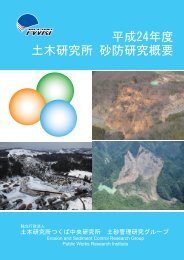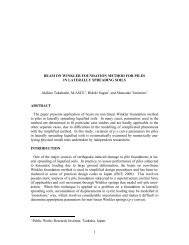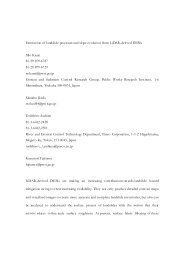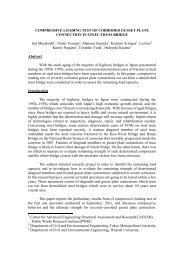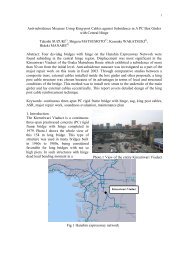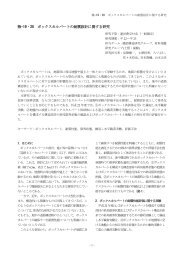SEATTLE'S SEISMIC RETROFIT PROGRAM David W. Korpi1 ...
SEATTLE'S SEISMIC RETROFIT PROGRAM David W. Korpi1 ...
SEATTLE'S SEISMIC RETROFIT PROGRAM David W. Korpi1 ...
Create successful ePaper yourself
Turn your PDF publications into a flip-book with our unique Google optimized e-Paper software.
Event. Additionally, the flared upper portion will not only provide confinement for the<br />
rocker bearing assembly, but will also provide additional seat width, thereby reducing the<br />
possibility of a girder becoming unseated from the column.<br />
Concept 2- Remove existing counterforts at Bent 3 and column jacket similar to<br />
Bents 4 thru 10. Removal of the counterforts allows the installation of steel column<br />
jackets in a standard member for greater continuity and reliability. Also, all of the<br />
benefits described in Concept 1 apply.<br />
Concept 3- Add full depth reinforced concrete grade beams at Bents 3 thru 10.<br />
Installation of full-depth reinforced concrete grade beams at these locations will provide<br />
substantially improved performance of the foundation system when loaded in the<br />
transverse direction. The foundations resistance to overturning will be greatly enhanced<br />
by linking the individual foundations together, providing a much greater moment of<br />
inertia for the pile group. Additionally, the unconfined concrete plinths will no longer be<br />
subjected to bending moments, so plastic hinging of the jacketed columns will provide<br />
the mechanism for deformation.<br />
Longitudinal capacity of the pile group to resist overturning will not be as greatly<br />
enhanced. However, utilizing additional passive resistance of the soil bearing on the<br />
grade beam will provide additional overturning resistance.<br />
Many of the concrete plinths extend 3.5-meters into the ground, so shoring will be<br />
required for the construction of most of the grade beams. This is of special concern where<br />
excavation takes place adjacent to railroad tracks, as both BNSF and UPRR have specific<br />
requirements for structural shoring located next to tracks.<br />
Concept 4- Add longitudinal restrainers at Bent 6 expansion joint. The in-span<br />
rocker bearing at Bent 6 was particularly vulnerable. The location does not lend itself to<br />
the installation of seat extensions, so we must rely on longitudinal restrainers to limit the<br />
relative displacement of the adjacent frames such that the rocker bearing maintains<br />
stability. We recommend placing these assemblies on the girders, which are quite<br />
substantial and will provide excellent anchorage. The restrainers should be gapped to<br />
allow for thermal expansion and contraction.<br />
The restrainer assemblies are to be placed above existing railroad tracks, making<br />
access to these locations both difficult and limited. The contractor will need to coordinate<br />
this work with the representative railroad company to ensure safety was addressed.<br />
Concept 5 – Add steel pipe transverse shear restrainers embedded in concrete<br />
bolsters at Bent 6 expansion joint. We propose the installation of steel pipe shear<br />
restrainers to provide shear resistance against differential transverse movements between<br />
Units 2 and 3. Additionally, this measure would provide a modicum of additional vertical<br />
support and may be viewed as seat extender.<br />
Similar to the installation of the longitudinal restrainer units, this work would take<br />
place in close proximity to active railroad tracks and requires careful coordination. It was<br />
240



